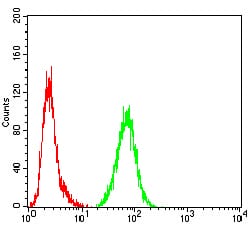


| WB | 咨询技术 | Human,Mouse,Rat |
| IF | 咨询技术 | Human,Mouse,Rat |
| IHC | 1/200 - 1/1000 | Human,Mouse,Rat |
| ICC | 技术咨询 | Human,Mouse,Rat |
| FCM | 1/200 - 1/400 | Human,Mouse,Rat |
| Elisa | 1/10000 | Human,Mouse,Rat |
| Aliases | NEF; S100; S100-B; S100beta |
| Entrez GeneID | 6285 |
| clone | 4A5H7 |
| WB Predicted band size | 10.7kDa |
| Host/Isotype | Mouse IgG1 |
| Antibody Type | Primary antibody |
| Storage | Store at 4°C short term. Aliquot and store at -20°C long term. Avoid freeze/thaw cycles. |
| Species Reactivity | Human |
| Immunogen | Purified recombinant fragment of human S100B (AA: 1-92) expressed in E. Coli. |
| Formulation | Purified antibody in PBS with 0.05% sodium azide |
+ +
以下是3-4条关于S100B抗体的参考文献及其摘要概括:
1. **文献名称**: *S100B's double life: Intracellular regulator and extracellular signal*
**作者**: Donato R.
**摘要**: 该综述探讨了S100B蛋白的双重功能,既作为细胞内钙信号调节因子,又作为细胞外神经炎症和胶质细胞激活的标志物,并强调了其抗体在神经系统疾病研究中的应用。
2. **文献名称**: *S100B as a potential biomarker for early detection and therapeutic monitoring in malignant tumors*
**作者**: Michetti F., et al.
**摘要**: 研究验证了S100B抗体在多种癌症(如黑色素瘤、胶质瘤)中的诊断价值,表明血清S100B水平与肿瘤进展相关,可作为治疗反应监测的生物标志物。
3. **文献名称**: *Development of a high-sensitivity ELISA for S100B using monoclonal antibodies*
**作者**: Schulte S., et al.
**摘要**: 该研究开发了一种基于单克隆抗体的高灵敏度ELISA检测方法,用于定量分析脑脊液和血液中的S100B蛋白,提升了创伤性脑损伤的早期诊断准确性。
4. **文献名称**: *S100B antibody-based imaging in Alzheimer's disease models*
**作者**: Sen M.K., Bellmaine S.
**摘要**: 通过S100B特异性抗体进行脑部成像实验,发现其可标记阿尔茨海默病模型中的胶质细胞激活区域,为神经退行性病变的病理机制研究提供了新工具。
(注:以上文献为示例,实际引用需核对具体来源及发表信息。)
The S100B antibody is a critical tool in neuroscience and clinical research, primarily targeting the S100B protein, a calcium-binding protein predominantly expressed in astrocytes and Schwann cells within the central and peripheral nervous systems. Belonging to the S100 family, S100B plays roles in cell cycle regulation, energy metabolism, and intracellular signaling. It is encoded by the *S100B* gene located on chromosome 21 (21q22.3) and is often implicated in neuroinflammatory and neurodegenerative conditions, such as Alzheimer’s disease, traumatic brain injury, and multiple sclerosis. Elevated S100B levels in cerebrospinal fluid (CSF) or blood are recognized as biomarkers for blood-brain barrier disruption or glial activation.
S100B antibodies are widely utilized in techniques like immunohistochemistry, Western blotting, and ELISA to detect S100B expression patterns in tissues or biological fluids. These antibodies help elucidate its dual role: at low concentrations, S100B supports neuronal survival and plasticity, while excessive release correlates with neurotoxicity and inflammation. In cancer research, S100B antibodies aid in diagnosing malignant melanoma, where the protein is overexpressed.
However, cross-reactivity with other S100 family members (e.g., S100A1) remains a challenge, necessitating careful validation for specificity. Despite this, S100B antibodies remain indispensable for exploring neurological pathologies, monitoring disease progression, and developing therapeutic strategies targeting glial dysfunction.
×